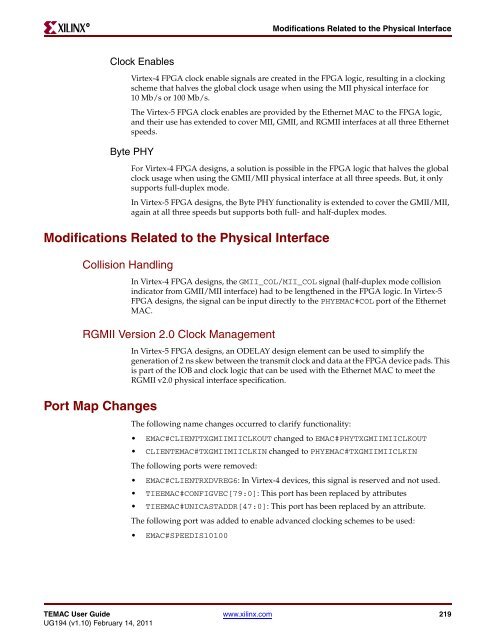Xilinx UG194 Virtex-5 FPGA Embedded Tri-Mode Ethernet MAC ...
Xilinx UG194 Virtex-5 FPGA Embedded Tri-Mode Ethernet MAC ...
Xilinx UG194 Virtex-5 FPGA Embedded Tri-Mode Ethernet MAC ...
You also want an ePaper? Increase the reach of your titles
YUMPU automatically turns print PDFs into web optimized ePapers that Google loves.
R<br />
Clock Enables<br />
Modifications Related to the Physical Interface<br />
<strong>Virtex</strong>-4 <strong>FPGA</strong> clock enable signals are created in the <strong>FPGA</strong> logic, resulting in a clocking<br />
scheme that halves the global clock usage when using the MII physical interface for<br />
10 Mb/s or 100 Mb/s.<br />
The <strong>Virtex</strong>-5 <strong>FPGA</strong> clock enables are provided by the <strong>Ethernet</strong> <strong>MAC</strong> to the <strong>FPGA</strong> logic,<br />
and their use has extended to cover MII, GMII, and RGMII interfaces at all three <strong>Ethernet</strong><br />
speeds.<br />
Byte PHY<br />
For <strong>Virtex</strong>-4 <strong>FPGA</strong> designs, a solution is possible in the <strong>FPGA</strong> logic that halves the global<br />
clock usage when using the GMII/MII physical interface at all three speeds. But, it only<br />
supports full-duplex mode.<br />
In <strong>Virtex</strong>-5 <strong>FPGA</strong> designs, the Byte PHY functionality is extended to cover the GMII/MII,<br />
again at all three speeds but supports both full- and half-duplex modes.<br />
Modifications Related to the Physical Interface<br />
Collision Handling<br />
In <strong>Virtex</strong>-4 <strong>FPGA</strong> designs, the GMII_COL/MII_COL signal (half-duplex mode collision<br />
indicator from GMII/MII interface) had to be lengthened in the <strong>FPGA</strong> logic. In <strong>Virtex</strong>-5<br />
<strong>FPGA</strong> designs, the signal can be input directly to the PHYE<strong>MAC</strong>#COL port of the <strong>Ethernet</strong><br />
<strong>MAC</strong>.<br />
RGMII Version 2.0 Clock Management<br />
Port Map Changes<br />
In <strong>Virtex</strong>-5 <strong>FPGA</strong> designs, an ODELAY design element can be used to simplify the<br />
generation of 2 ns skew between the transmit clock and data at the <strong>FPGA</strong> device pads. This<br />
is part of the IOB and clock logic that can be used with the <strong>Ethernet</strong> <strong>MAC</strong> to meet the<br />
RGMII v2.0 physical interface specification.<br />
The following name changes occurred to clarify functionality:<br />
E<strong>MAC</strong>#CLIENTTXGMIIMIICLKOUT changed to E<strong>MAC</strong>#PHYTXGMIIMIICLKOUT<br />
CLIENTE<strong>MAC</strong>#TXGMIIMIICLKIN changed to PHYE<strong>MAC</strong>#TXGMIIMIICLKIN<br />
The following ports were removed:<br />
E<strong>MAC</strong>#CLIENTRXDVREG6: In <strong>Virtex</strong>-4 devices, this signal is reserved and not used.<br />
TIEE<strong>MAC</strong>#CONFIGVEC[79:0]: This port has been replaced by attributes<br />
TIEE<strong>MAC</strong>#UNICASTADDR[47:0]: This port has been replaced by an attribute.<br />
The following port was added to enable advanced clocking schemes to be used:<br />
E<strong>MAC</strong>#SPEEDIS10100<br />
TE<strong>MAC</strong> User Guide www.xilinx.com 219<br />
<strong>UG194</strong> (v1.10) February 14, 2011

















